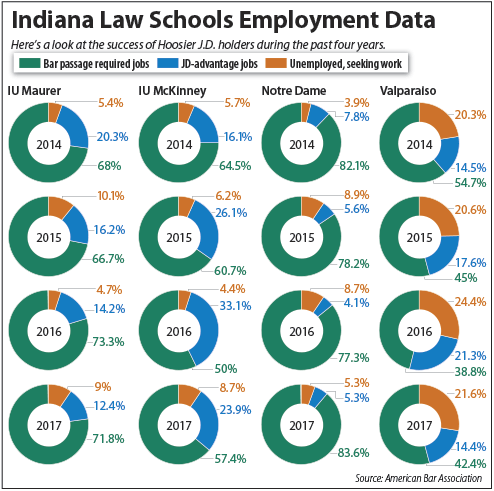Subscriber Benefit
As a subscriber you can listen to articles at work, in the car, or while you work out. Subscribe NowThe Class of 2017 graduating from Indiana law schools followed the national trend of being smaller than the previous class and posting better jobs numbers, but the Hoosier graduates moved in the opposite direction by posting a slight increase in unemployment, according new data released from the American Bar Association.
Nationally, of the 2017 law school graduates, 68.7 percent landed jobs that required bar passage, up from the Class of 2016’s rate of 64.5 percent in the same positions. However, the ABA is attributing the higher employment rate to the diminished class size. At 34,922 members, the Class of 2017 was 5.9 percent smaller than the previous year.
 In Indiana, the 2017 graduates also tallied an improvement with 65.6 percent getting bar-passage required jobs, compared to 59.5 percent of the Class of 2016. Moreover, at 739 members, the Indiana Class of 2017 was 4.2 percent smaller than the previous year.
In Indiana, the 2017 graduates also tallied an improvement with 65.6 percent getting bar-passage required jobs, compared to 59.5 percent of the Class of 2016. Moreover, at 739 members, the Indiana Class of 2017 was 4.2 percent smaller than the previous year.
The percentage of graduates going into J.D.-advantage positions fell. Of the Class of 2017, a total of 11.8 percent had those kinds of job, where 14.1 percent of the previous year’s class found employment in this category. Among Indiana graduates, 14.3 percent from the Class of 2017 held J.D.-advantage jobs, compared to 19.5 percent in 2016.
For 2017, Notre Dame Law School led in the percentage of graduates going to jobs where bar passage is required. Meanwhile, Indiana University Robert H. McKinney School of Law trumped in the percentage of graduates going into JD-advantage positions.
Notre Dame Law School assistant dean Kevin O’Rear said the South Bend campus is “really excited” about the Class of 2017’s achievements. “Our students are terrific,” he said.
Despite being one of the larger classes from Notre Dame at 207, last year’s graduates turned in the best employment numbers since the Class of 2012. The largest portion of Notre Dame graduates are taking positions in large law firms.
O’Rear attributed the success to students realizing they cannot just be smart and do well in the classroom. They also have to be active in their employment search. To help with that, the law school organizes mock interviews, enlisting more than 250 alumni to meet with the students and conduct a faux employer-job applicant meeting.
The Class of 2018 may continue the upward trend. O’Rear said the soon-to-be graduates right now are in an “extremely similar position” in regard to their job searches as the Class of 2017 was at this time last year.
Adding to the upbeat data from the ABA, unemployment also dropped among all law school graduates. In the 2017 class, 7.9 percent were unemployed and seeking work, an improvement from the 8.8 percent jobless rate of 2016 graduates.
However, joblessness inched higher among Indiana law school graduates. The Hoosier Class of 2017 had an unemployment rate of 10 percent, a slight increase over the 9.6 percent recorded for Class of 2016. Valparaiso Law School’s 2017 graduates had the highest unemployment rate among Indiana graduates at 21.6 percent.
As an adjunct faculty member at Indiana University Robert H. McKinney School of Law, Charles Daughtery is noticing more optimism about job prospects among the second- and third-year students. They have told him they either have positions or are confident they will soon be hired.
This is not only a change from just three years ago when his students were struggling to find employment, but also a dramatic shift from his own experience as a 2011 IU McKinney graduate. He was not able to land a summer associate position during his studies because of the market downturn, and when he graduated, so few jobs were available that he worked in construction.
Still, Daughtery kept reaching out to attorneys until he finally got a foothold in the legal industry. Today, he is an associate at Easter & Cavosie in Indianapolis and chair of the Young Lawyers Section of the Indiana State Bar Association.
Not surprisingly, he advises law school graduates they need to network or they will not work. They should get involved in professional organizations, such as the State Bar, and connect with attorneys.
“Lawyers want to help law students and new lawyers,” Daughtery said. “We genuinely want to see the best for the new young lawyers.”•
Please enable JavaScript to view this content.
